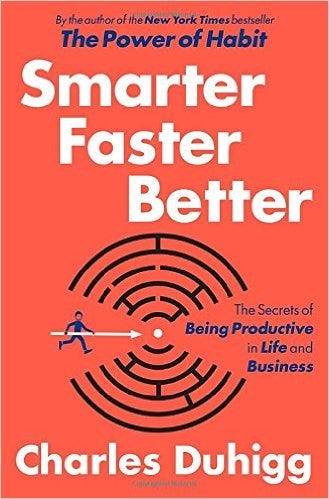This book explores the science of productivity, and why managing how you think is more important than what you think.

Learn to stay on track
Have you ever felt excited about something, for example, a new project, but after a while that excitement faded away?
Researchers at Columbia University found that people feel more motivated when they have greater control over the situation and when they get to make choices.
Neuropsychologist Mauricio Delgado found that “motivation centers” light up in the brain whenever we get to make a choice. Even something simple as selecting a color in a video game has this effect.
Now let’s apply this principle to situations when we are stuck with a task. Whenever you feel stuck, let yourself make a decision. Go for a 15 minutes walk and then come back to what you were doing, be creative.
However, we need to remember how our choices contribute to the bigger goals.
Remember the bigger picture (the WHY)
Remembering the bigger picture is another important element in staying motivated. You will feel better doing seemingly trivial tasks when you know it will bring you closer to something important.
Let’s say you want to learn a new skill and you start out by reading an essay about it. But it’s terribly boring, so you struggle to keep your attention on the text. How can you stay motivated and focused in this situation?
You could use a simple trick like writing on the top of the essay in bold letters: “This will help me to learn… ”. Remind yourself of what you want and why you are reading this.
Set bigger goals
Studies have shown that reaching for bigger goals makes people more creative.
In 1997 a study revealed that after Motorola had used stretch goals in its management training, engineers were able to develop new products in 1/10 of the time it took previously.
Let’s use that principle and start with your biggest ambitions, don’t be humble, let your imagination come up with your biggest goals.
But stretch goals can seem overwhelming, that’s where SMART goals come into play.
Break big goals into smaller ones
SMART (Specific, Measurable, Achievable, Realistic and Time-bound) goals are more manageable than the big goals.
Let’s say your big goal is to run a marathon. First, you’ll want to set a smaller goal like running 5 miles without stopping.
Your small goals should be realistic/achievable. Next, figure out how long you’ll need to reach your goal.
Each time you complete a small goal, you will get an extra motivation boost, you’ll be excited about your progress and getting closer to your big goal.
Stay focused and create mental models
Use imagination or mental models to get excited about the future and prepare yourself. Let’s say you face a challenge next week. Imagine how you will get through your challenge step by step.
Basically, you find out how you want the whole process to unfold in your imagination. Then you start working through it. Think about possible distractions and how you will deal with them.
Maybe your partner invites you to go out, how can you organize your activities in a way where you still get done everything on that day?
Create a great team
Google’s Project Aristotle researched for two years what makes teams great. They found that even a team of average performers can accomplish great things if the team has the right dynamic.
The biggest factor turns out to be whether team members feel psychologically safe. Team members feel safe when they know they and their ideas won’t be ridiculed. Safe teams were found to perform better, innovate and envision better and meet sales targets.
But why does psychological safety make a difference? Team members are more likely to admit mistakes, which means that issues can be addressed and fixed more quickly. Team members are also more likely to share unconventional ideas, which makes the team more creative.
Empathy is another important factor. Project Aristotle found that the safest teams are made up of empathetic individuals.
Contribution makes each member feel valued. Everyone should be able to make their voices heard at least once in every meeting. Team leaders are encouraged to promote participation of every member, which further adds psychological safety.
Resolve any conflicts as soon as they arise, encourage discussion in a caring way. Everyone should feel valued and respected.
Create a commitment culture
Research has shown that company culture is highly important to the success of any firm.
A commitment culture focuses on building trust and attachment to the company. Trust, care and emotional connections are the focal points of commitment cultures and get prioritized over smartness and high achievement in the hiring process. New individuals should fit the larger team and company vision.
An extensive study from Stanford Business School in 1994 showed that commitment cultures companies consistently proved to be the most successful. Not one of the 200 Silicon Valley technology startups they studied went bankrupt; they were the first to go public and had the highest ratios of profitability.
An interesting and beneficial side effect is that commitment culture companies need less middle management because individuals are better at managing themselves. Addressing questions more directly makes the company more efficient because managers often do not possess the knowledge of the experts who could make a decision immediately.
Use old ideas in new ways
Prior knowledge can help creativity.
The innovative papers were considered groundbreaking because they approached existing concepts from a new angle and made unusual connections and combinations.
Use feelings to foster creativity
Let emotions and intuition guide you. Disney Animation President Edwin Catmull used this principle in the creation of the movie Frozen. His team explored their emotional connections with siblings in order to portray the relationship between the characters Anna and Elsa in a raw and authentic way.
